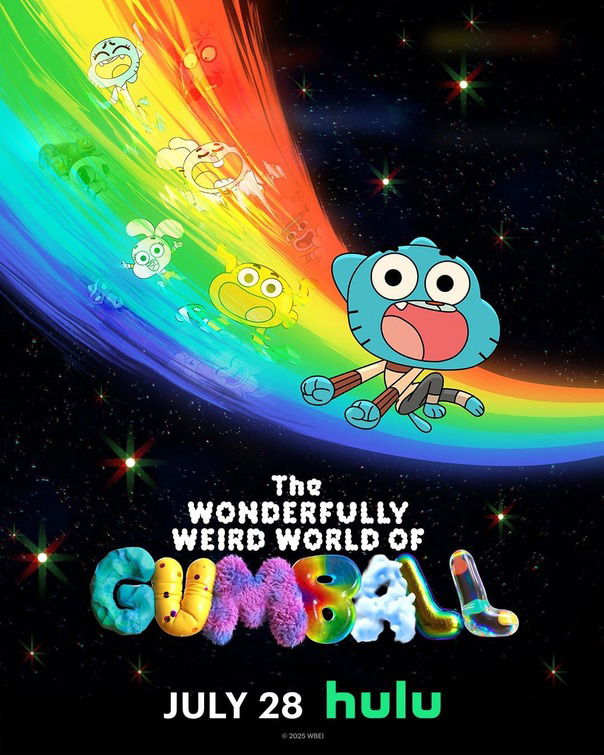“Welcome Back to Elmore”

| None | Light | Moderate | Heavy | |
|---|---|---|---|---|
| Language | ||||
| Violence | ||||
| Sex | ||||
| Nudity |
What You Need To Know:
The first six episodes of THE WONDERFULLY WEIRD WORLD OF GUMBALL feature colorful animation, fast pacing and quirky characters. The voice actors are good, and the humor often lands. The episodes have a light moral worldview. Characters make wrong decisions but often learn their lesson. One episode portrays the importance of family despite the mother’s annoyance with her family members. However, THE WONDERFULLY WEIRD WORLD OF GUMBALL sometimes gets bogged down in some inappropriate scatological humor, adult hypocrisy and occasional political correctness.
Content:
Light moral worldview where, in most episodes, the characters make wrong decisions but learn their lesson at the end of the episode, one episode portrays the importance of family despite the mother’s annoyance with her family members, there are light Romantic elements in Episode 1.5 where title character tells his principal to be true to who he is, and the episode has a theme about self-esteem, Episode 1.1 has a politically correct, anti-capitalist comment and elements against rich people controlling society (the episode has a rich character who runs a fast food chain but controls the food supply, and the two main characters discover this fact while trying to find some healthy food somewhere, but the rich character makes healthy food too expensive and destroys their garden when they try to grow their own healthy food), plus some brief Eastern, mystical false theology is played for laughs such as title character thanks the Universe in Episode 1.6, a character refers to chakra in Episode 1.1, and father has a mystical relationship to food in Episode 1.5, where eating food helps him remember important past events (he has a problem with his short term memory when it comes to orders from his wife);
Comical references to people’s rear ends in Episode 1.5 creates many uses of the word “butt,” 15 instances of calling people dumb, one dagnabbit, dust appears in a character’s mouth, a reference to eating gunk in the sink, two characters spit food and drink into each other’s mouths, there’s a rat in someone’s mouth, one episode has lots of comedy about people’s rear ends, snot comes out of a character’s nose in Episode 1.3, and a character makes passing gas sounds;
More Detail:
MOVIEGUIDE® watched the first six episodes of THE WONDERFULLY WEIRD WORLD OF GUMBALL.
The first episode, “The Burger,” acknowledges the passage of time between the two series. Gumball and Darwin scramble to find a healthier alternative to eat than fast food hamburgers. Their search leads to a struggle against the corruption of a rich owner of a fast food chain who seems to have totally manipulated the food industry.
In the second episode, “The Assistant,” Gumball and Darwin’s mother must deal with her family’s lack of help around the house and the existence of an artificial intelligence in her life.
In the third episode, “The Distance,” Gumball and Darwin’s constant togetherness drives their mom to separate them in different rooms, aiming to teach them independence. However, Gumball strongly opposes this idea.
In the fourth episode, “The Thing,” before their paternal grandmother visits them, their father must figure out something their mother mentioned recently or risk losing his marriage.
In the fifth episode, “The Butts,” Gumball wants to read his poem about butts in school, but his principal forbids him to do so because of his insecurity about his butt.
In the sixth episode, “The Traffic,” their mother wants to take the family to an amusement park before it closes forever, as a gift for their sister, Anais.
The first six episodes of THE WONDERFULLY WEIRD WORLD OF GUMBALL are like an animated fever dream. They feature colorful, simple animation with fast pacing and quirky characters who are aware of their existence within the show and in the real world. The voice actors give great performances, and the humor sometimes lands. As the title suggests, weirdness ensues in every episode as if someone walked into a fever dream and has a hard time getting out. The episodes blend of 2-D and 3-D characters works because of the strangeness of the whole endeavor.
However, the filmmakers overdo Gumball and Darwin’s shenanigans, as they did in the original cartoons. Also, the parents demonstrate hypocrisy when teaching the children to behave, because they also do things they shouldn’t. The series goes to inappropriate and bizarre places with “The Butts” episode in particular. The episode presents the principal’s insecurity with how his tiny rear end looks, but it has too many rear end shots which distract from the message. The series should have toned down that episode’s immaturity.
In most of the first six episodes, though, the series presents a light moral worldview. For example, characters make the wrong decisions but learn their lesson at the end of the episode. One episode portrays the importance of family despite the mother’s annoyance with her family members. Ultimately, the showrunners tackle complicated topics with humor. The first six episodes also have some light Romantic elements where Gumball, the title character, advises another character to be true to himself and have self-esteem.
MOVIEGUIDE® advises caution for older children because of the scatological humor, adult hypocrisy and occasional political correctness in the first six episodes. The negative content dilutes the program’s positive moral and child friendly elements.


 - Content:
- Content: 

